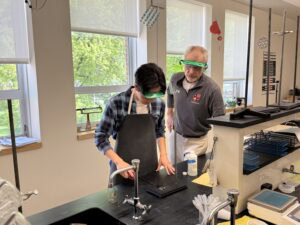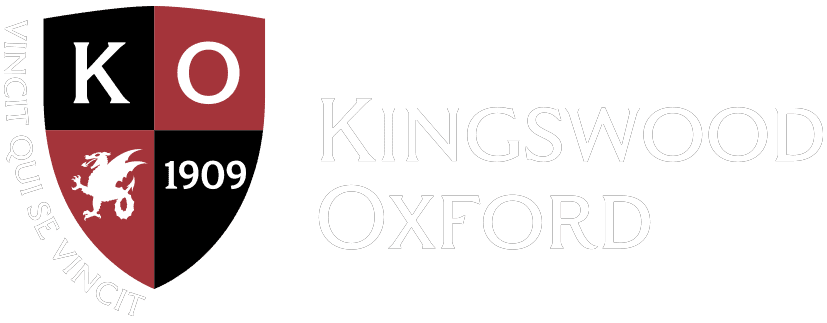September 30, 2025
From the Iron Curtain to Inquiry
In 1983, the Cold War cast a long shadow over Eastern Europe. For Upper School science teacher Tomas Kopecky, then a teenager in Czechoslovakia, the world became more ominous after the Soviets shot down a South Korean commercial aircraft. After that tragedy, his family decided to flee the country and head to the United States, where he attended the University of Connecticut and later Boston University, studying science.
Teaching was not just a career choice for Kopecky; it was something ingrained in him from childhood. His grandmother and aunt were both teachers, and he still remembers tagging along to their classrooms. “I loved being with the kids and watching them learn,” he says. Later, as a teenager, he coached younger players at his tennis club and discovered the joy of helping someone reach that breakthrough moment. “When a little kid finally hit the ball over the net after the seventeenth try, and their face just lit up – I loved that feeling. That’s when I thought maybe teaching was what I wanted to do.”
At first, he tried mathematics. A gifted student in both math and science, it seemed like a natural path. But the classroom experience quickly felt flat. “It was too abstract and dry. Just formulas and symbols on the board. I could see why students asked, ‘When will I ever use this?’” So then I thought, well, maybe I can still do the math within the science endeavor because math is a major tool in science.”
Over three decades of teaching, Kopecky has refined a philosophy that emphasizes discovery over memorization. He calls it constructivism – the idea that students learn best when they actively construct their own understanding. “When you walk into my classroom,” he said, “you will see a lot of kids doing a lab or working with models or even using the whiteboards, drawing things, looking at tables with numbers and data, and see if they can make sense of it.” In practice, this means his classroom resembles a laboratory or workshop more than a lecture hall. Rather than receiving facts, they are asked to notice patterns, test hypotheses, and explain their reasoning.
“I want my students to mimic the way real scientists work,” Kopecky says. “In research, nobody tells you the answers. You have to figure them out. That’s how I want them to experience science.”
This approach can be demanding. Some students initially resist, preferring to be told what they need to know. And for Kopecky, the method requires flexibility. “Sometimes I have to slow down and ask, ‘how can I help them uncover this relationship for themselves?’ It means we may not cover every single topic, but the ones we do explore, we go deep.”
He also embraces differentiation, tailoring lessons to meet the needs of different learners. Advanced students may receive challenging problems to stretch their thinking, while others work closely with him in small groups.
A hallmark of Kopecky’s teaching is open-ended experimentation. Roughly a third of his labs give students the problem but not the procedure. “It’s more open-ended where the students know what they are supposed to investigate,” he said “but I’m not telling them how to do it. They have to design their own procedures, their own data tables, and make sense of the data.”
Of course, not every attempt goes smoothly — and that’s precisely the point. “Mistakes are part of science,” Kopecky insists. “Look at COVID. Early on, we made some mistakes when we thought we knew how the virus was spreading.” He said that as more information became available, they modified their approach accordingly. “Science doesn’t have all the answers,” he said. “Science always has more questions.”
This mindset also shapes how he encourages creativity and critical thinking. When students veer off track, he doesn’t correct them outright but asks guiding questions: Why do you think this will happen? What makes you think that? He wants to hear their reasoning, even if it’s flawed, because the process itself is what matters.
His most meaningful moments are often the quiet ones — a student who once “hated science” beginning to love it by year’s end. “It doesn’t happen 10 out of 10 times, but if it happens once in a while, it’s all worth it.”
Over time, Kopecky has witnessed the classroom transform. From transparency projectors to laptops, from paper charts to digital sensors, each innovation has transformed the way students engage with science. More recently, he has begun experimenting with artificial intelligence as both a support tool and a digital tutor.
“I used it first for students to check their work — to compare what they had done with what AI suggested. Now I’m moving toward using it as a tutor. The AI asks questions back, guiding students step by step instead of just giving answers.”
While he acknowledges the challenges of balancing curriculum demands, time constraints, and new initiatives, Kopecky remains committed to growth. He subscribes to a teaching organization that has a website, blog, and podcast. “It’s always useful because they do something that I haven’t thought of yet.” He sometimes employs these new techniques, but not all of them are perfect. “Sometimes the changes work, and sometimes they don’t,” he said. “You have to be introspective and question whether the tweaks you did are really beneficial. That’s what makes teaching fun, because every day is a little bit different.”
From the uncertainty of leaving Czechoslovakia to the certainty of shaping young scientists, Tomas Kopecky’s journey reflects both resilience and a deep love of learning. His classroom is a space where curiosity matters more than perfection, where mistakes are part of discovery, and where science is not a set of answers but an ongoing conversation with the unknown.
Tomas Kopecki
Boston University, B.A.
State University of New York, Stony Brook, M.S.
Profiles Main News
